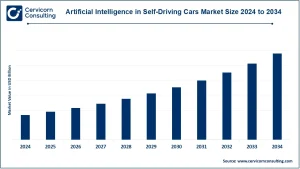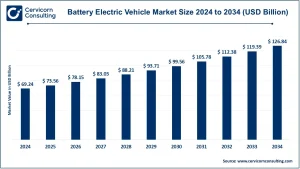Market Overview
The global transportation market serves as a fundamental driver of economic development and global connectivity. It encompasses both passenger and freight movement across multiple modes—road, rail, air, and sea—while increasingly integrating innovative solutions such as urban air mobility (UAM) and autonomous vehicles. Valued at approximately USD 8.54 trillion in 2024, the market is forecasted to reach around USD 17.23 trillion by 2034, growing at a CAGR of 7.27% from 2025 to 2034. This expansive ecosystem includes infrastructure development, automotive and aerospace manufacturing, logistics services, and next-generation digital technologies such as Mobility-as-a-Service (MaaS), electric vehicle (EV) networks, and AI-enabled traffic management platforms.
👉 Get a Free Sample: https://www.cervicornconsulting.com/sample/2631
Key Market Trends
1. Electrification of Transport
The transition toward sustainable mobility is accelerating with the rapid adoption of electric vehicles across passenger, commercial, and mass transit systems. Technological progress in battery performance, expansion of charging infrastructure, and government incentives are fueling global EV growth. Countries like Norway and China lead this shift, setting new benchmarks for clean transportation.
2. Autonomous and Connected Vehicles
Automation is revolutionizing how people and goods move. Autonomous vehicles (AVs) are being tested for applications such as logistics, ride-hailing, and fleet management. The integration of 5G and Internet of Things (IoT) connectivity enhances safety, navigation, and real-time operational efficiency.
3. Urban Air Mobility (UAM)
Electric vertical takeoff and landing (eVTOL) aircraft are emerging as a transformative solution to urban congestion. Companies like Joby Aviation and Volocopter are pioneering air taxi services and collaborating with regulators to build vertiports and commercial flight routes.
4. Mobility-as-a-Service (MaaS)
The rise of integrated digital platforms is enabling seamless multimodal travel by combining public, private, and shared mobility options. MaaS simplifies commuting, cuts emissions, and aligns with global smart city goals.
5. Sustainable Logistics and Smart Freight
Supply chains are adopting green logistics practices—electric delivery fleets, drone-based last-mile solutions, and carbon-neutral warehousing. Predictive analytics and automation are improving route optimization and operational sustainability.
Market Drivers
-
Rapid Urbanization and Population Growth: Expanding cities are increasing the need for efficient transport networks and last-mile connectivity. By 2030, over 5 billion people are expected to live in urban areas, necessitating major infrastructure investments.
-
Government Support and Incentives: Programs such as the U.S. Bipartisan Infrastructure Law, the EU Green Deal, and China’s 14th Five-Year Plan are accelerating EV deployment, high-speed rail expansion, and low-emission transit systems.
-
Technological Innovation: Continuous advancements in EV batteries, AI-powered transport systems, and connected vehicle networks are improving safety, reliability, and performance.
-
Evolving Consumer Behavior: Consumers are increasingly prioritizing sustainability, shared mobility, and digital convenience, driving growth in MaaS and EV adoption.
-
E-commerce Expansion: The exponential rise of online retailing is boosting demand for efficient logistics and automated delivery systems, including drones and autonomous trucks.
Impact of Trends and Drivers
-
Passenger Mobility: Electrification and MaaS platforms are reducing car ownership while encouraging the use of shared, sustainable transport. UAM and autonomous taxis are emerging as next-generation mobility solutions in urban centers.
-
Freight & Logistics: Smart, connected fleets and drone-enabled deliveries are revolutionizing logistics, especially in North America and Asia-Pacific, where e-commerce growth remains strong.
-
Regional Insights:
-
North America: Government investment in EV infrastructure and pilot UAM programs.
-
Europe: Cross-border electric rail development and stringent emission targets under the Green Deal.
-
Asia-Pacific: Leadership in EV manufacturing, battery innovation, and smart mobility deployment.
-
Challenges & Opportunities
Challenges:
-
High upfront costs for EVs, charging infrastructure, and eVTOL systems.
-
Regulatory complexities surrounding autonomous and air mobility operations.
-
Cybersecurity and data privacy risks in digitalized transport systems.
Opportunities:
-
Expansion of EV infrastructure and clean transport networks.
-
Commercialization of UAM services in congested cities.
-
Growth in AI-driven logistics and smart traffic management solutions.
-
Increased public-private partnerships (PPPs) for infrastructure modernization.
Future Outlook
The transportation market is on a strong growth trajectory, expected to nearly double from USD 8.54 trillion in 2024 to USD 17.23 trillion by 2034, advancing at a CAGR of 7.27%. Innovations such as electric mobility, autonomous systems, UAM, and MaaS will redefine how goods and people move, fostering cleaner, faster, and smarter global connectivity. As sustainability and digital transformation continue to guide industry investments, the coming decade will mark a pivotal shift toward intelligent and eco-efficient mobility ecosystems.

